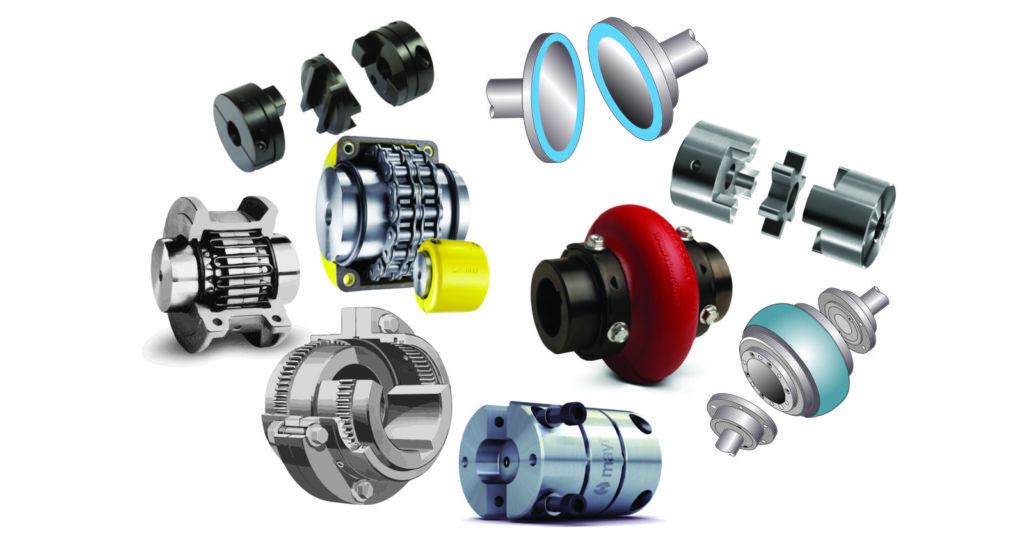Updated May 2019 || As outlined in our coverage of couplings for motion control — here at this couplingtips.com article — couplings connect rotating shafts powered by a drive of some type — often an electric motor.
All couplings serve to transmit drive torque and angular velocity. But applications for motion control (such as axes to position loads) usually use disc, slit or beam, curved-jaw, bellows, and other zero-backlash couplings capable of precise transmission of torque.
In contrast, applications for power transmission (as in grinding machines, pumps, and material-handling machinery) commonly include disc, gear, chain, elastomer tire, grid, jaw, and Oldham couplings. Such PT couplings transmit more torque on average than couplings designed for motion control … even to millions of lb-in. Plus they’re more rugged to withstand challenging environments.
Chain couplings — with typical maximum torques to 220,000 lb-in. at their largest — wrap lengths of chain around sprockets with clearances to impart flexibility.
These power-transmission couplings excel in high-horsepower applications on axes needing correction of up to 2° and 0.01-in. angular and parallel misalignment.
Diaphragm couplings — with typical maximum torques to 500,000 lb-in. at their largest — transmit power through a metal membrane (sometimes of varying thickness or ganged in arrays).
Though often more costly than other options, diaphragm couplings mitigate and avoid problematic transmission of forces and moments t coupled equipment such as bearings. Profiles include straight-spoked diaphragms; tapered diaphragms; and convoluted diaphragms assembled in arrays. These correct up to 1° and 0.1-in. angular and parallel misalignment.
Elastomeric tire couplings — with typical maximum torques to 550,000 lb-in. at their largest — transmit power through a tire-shaped rubber element that bridges the coupling’s two hubs. These correct up to 1° and 0.2-in. angular and parallel misalignment.
Jaw couplings — with typical maximum torques to 550,000 lb-in. at their largest — include both straight and curved variations. Much like disc couplings, the design lends itself to adaptation to both power transmission and backlash-free motion control. The coupling hubs have jaws that lock into a spider made of bronze, elastomer, or other material. Power transmission is reliable even through 1° and 0.01 in. angular and parallel misalignment.
Oldham couplings — with typical maximum torques to 550,000 in. at their largest — include a metal or polymer disc with slots on each face 90° offset. Usually hub fins or tenons engage a slotted disc that’s free to slide even while transmitting torque. Oldham couplings for accommodation of angular misalignment might transmit through 6° and 0.05 in. Oldham couplings to primarily address parallel misalignment might address 0.15 in. or more and 0.5° or so.
Disc couplings — with typical maximum torques to 5,000,000 lb-in. at their largest — are one of a few coupling types that come in variations to satisfy motion-control or power-transmission applications. Single thin discs or multi-disc packs (made of metal or engineered composite) bridge the hubs. In representative designs, the discs impart flexibility to transmit torque even while addressing up to 2° and 0.05 in. angular and parallel misalignment.
Grid couplings — with typical maximum torques to 5,000,000 lb-in. at their largest — include a heavy spring that weaves between slots on the coupling hubs. Compliant connection damps torsional vibration and shock loading — typically even through 0.3° and 0.30 in. angular and parallel misalignment.
Gear couplings — with typical maximum torques to 55,000,000 lb-in. at their largest — include a flexible joint on each hub. In most variations, a spindle joins the two. Each joint includes gearset that mates with a 1:1 ratio. The tooth flanks and external gearing’s outer diameter are crowned to allow rotating-spline action and accommodate misalignment of 3° and 0.04 to 0.4 in. on average.
